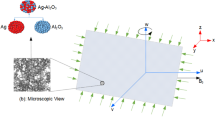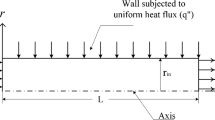Abstract
Adding variety of nanoparticles to the base fluid is current technique in order to boost the thermal performance of conventional fluids and mononanofluids. The forthright intention of the present investigation is to analyze numerically the up-to-date progress in flow and heat transport nature of magnetohydrodynamic, radiative Newtonian fluid, water-based Al2O3 nanofluid, water-based graphene nanofluid and water based Al2O3 + graphene hybrid nanofluid due to convectively heated stretching sheet. The flow equations are transformed by applying appropriate transformations into a pair of self-similarity equations. Further similarity equivalences are numerically solved through Runge–Kutta based shooting method. Graphs and tables are structured to analyze the behavior of sundry influential variables. From this study it is found that rate of heat transfer for Graphene + water is 2.921934, Al2O3 + H2O + Graphene is 2.250658 and Al2O3 + H2O is 3.260554. From this we conclude that water based Al2O3 + graphene hybrid nanofluid can be opted for cooling performance. Water based Al2O3 nanofluid significantly enhance convection heat transfer performance over a stretching sheet. Friction at the wall for Graphene + water is (− 1.719525), Al2O3 + H2O + Graphene is (− 2.256614) and Al2O3 + H2O is (− 1.959539). From this we conclude that water based Al2O3 + graphene hybrid nanofluid shows lower wall friction rate compared to other two mixture compositions.








Similar content being viewed by others
Abbreviations
- \(u_{1} ,v_{1}\) (ms−1):
-
Velocity components
- \(x_{1} ,y_{1}\) (m):
-
Cartesian coordinates
- \(T\) (K):
-
Temperature of the fluid
- \(T_{w}\) (K):
-
Wall Temperature
- \(T_{\infty }\) (K):
-
Ambient fluid temperature
- \(g\) (ms−2):
-
Acceleration due to gravity
- \(k\) (W m−1 K−1):
-
Thermal conductivity
- p (kg m−1 s−2):
-
Pressure
- µ (kg m−1 s−1):
-
Dynamic viscosity
- \(\upsilon \left( {{\text{m}}^{2} \;{\text{s}}^{ - 1} } \right)\) :
-
Kinematic viscosity
- \(\rho \left( {{\text{kg}}\;{\text{m}}^{ - 3} } \right)\) :
-
Fluid density
- \(c_{p}\)(J kg−1 K−1):
-
Specific heat capacity at constant pressure
- \(\sigma^{*}\) (W m K−4):
-
Stefan–Boltzmann constant
- \(\tau_{w} \left( {{\text{kg}}\;{\text{m}}^{ - 1} \;{\text{s}}^{ - 2} } \right)\) :
-
Wall shear stress
- \(k^{*}\) :
-
Mean absorption coefficient
- \(M\) :
-
Magnetic parameter
- \(Bi\) :
-
Biot number
- \(\sigma\) \(\left( {{\text{kg}}^{ - 1} \;{\text{m}}^{3} \;{\text{A}}^{2} } \right)\) :
-
Electrical conductivity
- \(\phi\) :
-
Nano particle volume fraction
- \(\Pr\) :
-
Prandtl number
- \(R\) :
-
Radiation parameter
- \(\zeta\) :
-
Similarity variable
- \(C_{f}\) :
-
Skin friction coefficient
- \(Nu_{x}\) :
-
Local Nusselt number
- \(\text{Re}\) :
-
Local Reynolds number
- \(\infty\) :
-
Ambient condition
- \(f\) :
-
Regular fluid
- \(nf\) :
-
Single nanoparticle nanofluid
- \(hnf\) :
-
Hybrid nanofluid
References
Abd El-Aziz M, Afify AA (2019) MHD Casson fluid flow over a stretching sheet with entropy generation analysis and Hall influence. Entropy 21(6):592
Abdelrazek AH, Kazi SN, Alawi OA, Yusoff N, Oon CS, Ali HM (2020) Heat transfer and pressure drop investigation through pipe with different shapes using different types of nanofluids. J Therm Anal Calorim 139(3):1637–1653
Babar H, Sajid MU, Ali HM (2019) Viscosity of hybrid nanofluids: a critical review. Therm Sci 23(3 Part B):1713–1754
Chen A, Lin TF, Ali HM, Yan WM (2020) Experimental study on bubble characteristics of time periodic subcooled flow boiling in annular ducts due to wall heat flux oscillation. Int J Heat Mass Transf 2020(157):119974
Goodarzi M, Tlili I, Tian Z, Safaei MR (2019) Efficiency assessment of using graphenenanoplatelets-silver/water nanofluids in microchannel heat sinks with different cross-sections for electronics cooling. Int J Numer Methods Heat Fluid Flow 30(1):347–372
Gopal D, Naik SH, Kishan N, Raju CS (2020) The impact of thermal stratification and heat generation/absorption on MHD Carreau-nano fluid flow over a permeable cylinder. SN Appl Sci 2(4):1
Hayat T, Aziz A, Muhammad T, Alsaedi A (2019) Numerical simulation for Darcy–Forchheimer three-dimensional rotating flow of nanofluid with prescribed heat and mass flux conditions. J Therm Anal Calorim 136(5):2087–2095
Khalid SU, Babar H, Ali HM, Janjua MM, Ali MA (2020) Heat pipes: progress in thermal performance enhancement for microelectronics. J Therm Anal Calorim. https://doi.org/10.1007/s10973-020-09820-7
Kumar R, Raju CS, Sekhar KR, Reddy GV (2019) Three dimensional MHD ferrous nanofluid flow over a sheet of variable thickness in slip flow regime. J Mech 35(2):255–266
Kumar KG, Lokesh HJ, Shehzad SA, Ambreen T (2020a) On analysis of Blasius and Rayleigh–Stokes hybrid nanofluid flow under aligned magnetic field. J Therm Anal Calorim 139(3):2119–2127
Kumar KA, Sugunamma V, Sandeep N (2020b) Influence of viscous dissipation on MHD flow of micropolar fluid over a slendering stretching surface with modified heat flux model. J Therm Anal Calorim 139(6):3661–3674
Manjunatha S, Kuttan BA, Jayanthi S, Chamkha A, Gireesha BJ (2019) Heat transfer enhancement in the boundary layer flow of hybrid nanofluids due to variable viscosity and natural convection. Heliyon 5(4):e01469
Muhammad K, Hayat T, Alsaedi A, Ahmad B (2020) Melting heat transfer in squeezing flow of basefluid (water), nanofluid (CNTs + water) and hybrid nanofluid (CNTs + CuO + water). J Therm Anal Calorim 19:1–8
Raju CS, Mamatha SU, Rajadurai P, Khan I (2019a) Nonlinear mixed thermal convective flow over a rotating disk in suspension of magnesium oxide nanoparticles with water and EG. Eur Phys J Plus 134(5):196
Raju CS, Saleem S, Al-Qarni MM, Upadhya SM (2019b) Unsteady nonlinear convection on Eyring-Powell radiated flow with suspended graphene and dust particles. Microsyst Technol 25(4):1321–1331
Raju CS, Sandeep N, Ali ME, Nuhait AO (2019c) Heat and mass transfer in 3-D MHD Williamson–Casson fluids flow over a stretching surface with non-uniform heat source/sink. Therm Sci 23(1):281–293
Sajid MU, Ali HM (2018) Thermal conductivity of hybrid nanofluids: a critical review. Int J Heat Mass Transf 126:211–234
Sajid MU, Ali HM (2019) Recent advances in application of nanofluids in heat transfer devices: a critical review. Renew Sustain Energy Rev 103:556–592
Sajid MU, Ali HM, Sufyan A, Rashid D, Zahid SU, Rehman WU (2019) Experimental investigation of TiO2–water nanofluid flow and heat transfer inside wavy mini-channel heat sinks. J Therm Anal Calorim 137(4):1279–1294
Sarafraz MM, Safaei MR (2019) Diurnal thermal evaluation of an evacuated tube solar collector (ETSC) charged with graphenenanoplatelets-methanol nano-suspension. Renew Energy 142:364–372
Sarafraz MM, Safaei MR, Tian Z, Goodarzi M, BandarraFilho EP, Arjomandi M (2019) Thermal assessment of nano-particulate graphene-water/ethylene glycol (WEG 60: 40) nano-suspension in a compact heat exchanger. Energies 12(10):1929
Seth D, Shrivastava RL, Shrivastava S (2016) An empirical investigation of critical success factors and performance measures for green manufacturing in cement industry. J Manuf Technol Manag 27(8):1076–1101
Seth D, Rehman MAA, Shrivastava RL (2018) Green manufacturing drivers and their relationships for small and medium (SME) and large industries. J Clean Prod 198:1381–1405
Shahsavar A, Ali HM, Mahani RB, Talebizadehsardari P (2020) Numerical study of melting and solidification in a wavy double-pipe latent heat thermal energy storage system. J Therm Anal Calorim. https://doi.org/10.1007/s10973-020-09864-9
Sheikholeslami M, Gerdroodbary MB, Shafee A, Tlili I (2019) Hybrid nanoparticles dispersion into water inside a porous wavy tank involving magnetic force. J Therm Anal Calorim. https://doi.org/10.1007/s10973-019-08858-6
Sriharan G, Harikrishnan S, Ali HM (2020) Experimental investigation on the effectiveness of MHTHS using different metal oxide based nanofluids. J Therm Anal Calorim. https://doi.org/10.1007/s10973-020-09779-5
Tariq HA, Anwar M, Malik A, Ali HM (2020) Hydro-thermal performance of normal-channel facile heat sink using TiO2–H2O mixture (Rutile-Anatase) nanofluids for microprocessor cooling. J Therm Anal Calorim. https://doi.org/10.1007/s10973-020-09838-x
Uma Devi S, Anali Devi SP (2017) Heat transfer enhancement of Cu–Al2O3/water hybrid nanofluid flow over a stretching sheet. Niger Math Soc 36:419–433
Upadhya SM, Devi RLVR, Raju CSK et al (2020) Magnetohydrodynamic nonlinear thermal convection nanofluid flow over a radiated porous rotating disk with internal heating. J Therm Anal Calorim. https://doi.org/10.1007/s10973-020-09669-w
Wakif A, Chamkha A, Thumma T, Animasaun IL, Sehaqui R (2020) Thermal radiation and surface roughness effects on the thermo-magnetohydrodynamic stability of alumina–copper oxide hybrid nanofluids utilizing the generalized Buongiorno’s nanofluid model. J Therm Anal Calorim. https://doi.org/10.1007/s10973-020-09488-z
Author information
Authors and Affiliations
Corresponding author
Additional information
Publisher's Note
Springer Nature remains neutral with regard to jurisdictional claims in published maps and institutional affiliations.
Rights and permissions
About this article
Cite this article
Raju, C.S.K., Upadhya, S.M. & Seth, D. Thermal convective conditions on MHD radiated flow with suspended hybrid nanoparticles. Microsyst Technol 27, 1933–1942 (2021). https://doi.org/10.1007/s00542-020-04971-x
Received:
Accepted:
Published:
Issue Date:
DOI: https://doi.org/10.1007/s00542-020-04971-x




